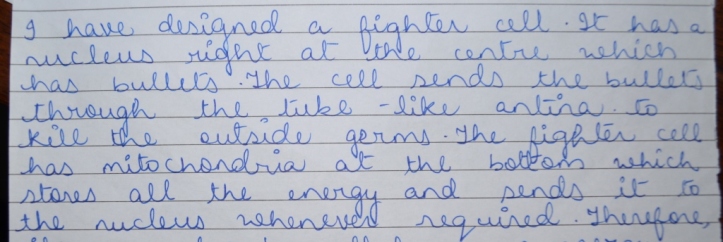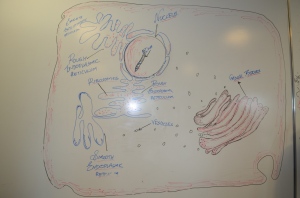ALF is full of budding doctors and scientists, making it a priority for us to find ways to build scientific skills in our students. When teaching the topic of Cells in ninth standard, girls got the chance to stretch themselves and really think about cells and how they work.
In the first lesson girls had to design a new cell to do a specific job, e.g. a messenger cell, a cell who fights with the germs, cell which transports gases, etc. Most of the girls’ designs were similar to the actual structure of various cells, although some designs were more out of the box.

This was a good exercise since girls got to start thinking about structure being related to function, and analysing various imaginative designs made by the girls made it easier for us to consider actual cell morphology.

Later on, colourful pictures, videos and diagrams helped explain cell morphology, and girls were amazed to know how structure and function of cells are connected, for example, sperm cells having a long tail in order to be able to swim.
Next, we looked at the plasma membrane, cell wall, nucleus, endoplasmic reticulum and so on. An experiment to explain diffusion in cells was very helpful indeed.


Whilst studying the cell membrane, girls did an experiment to observe pre-osmotic and post osmotic changes in a potato slice.

Finally, how could we help girls understand the interconnected functions of the nucleus, endoplasmic reticulum, ribosomes and golgi? Girls were divided into groups and provided with information on those four organelles, and they had thirty minutes to figure out how they worked together to synthesise protein. After this, each group presented their ideas to the class.



After wrapping up our topic on cells, girls were set an assignment “A day in the life of a cell”, imagining the places that a cell goes, and jobs it does, during one day. More than making their assignment attractive or amusing, girls had to demonstrate knowledge of a number of organelles and cellular processes.

Girls learnt to make connections between structure and function, they got to grips with some complicated cellular processes, and saw the cell come to life from the pages of their textbooks! We hope that through using a wide variety of methods we helped all girls make sense of cells.

Absolutely amazing way to learn so creatively. To see the connection between the structure and function of a cell. Fantastic teaching and learning.
Reblogged this on Shiksha and commented:
And that’s how we taught Cell: the unit of life